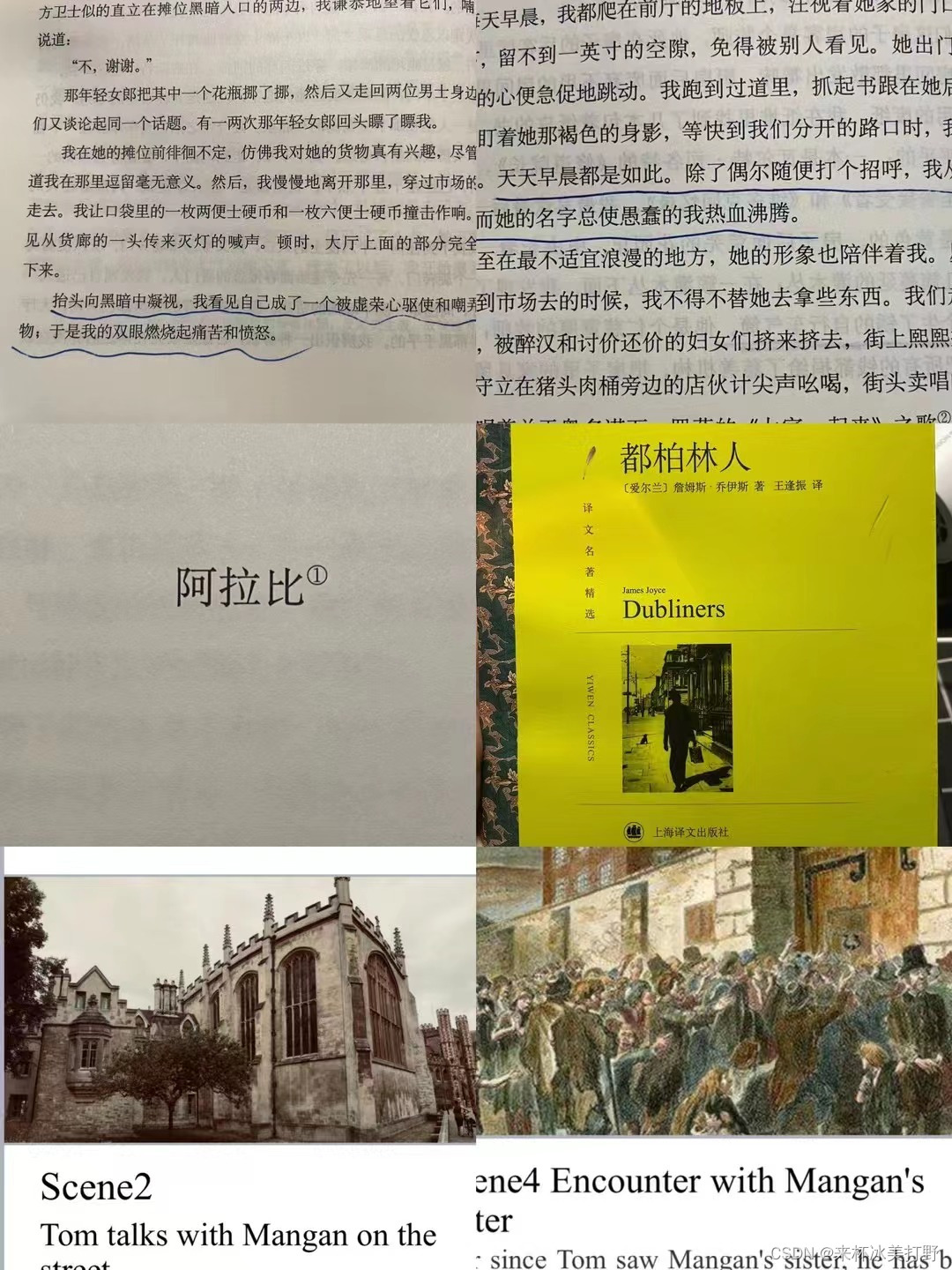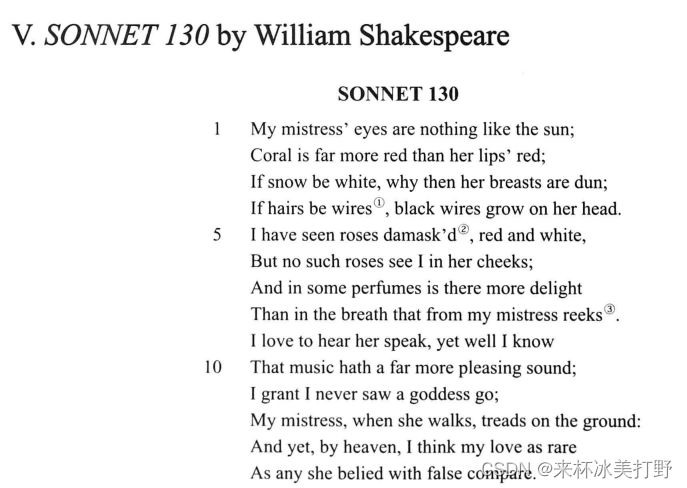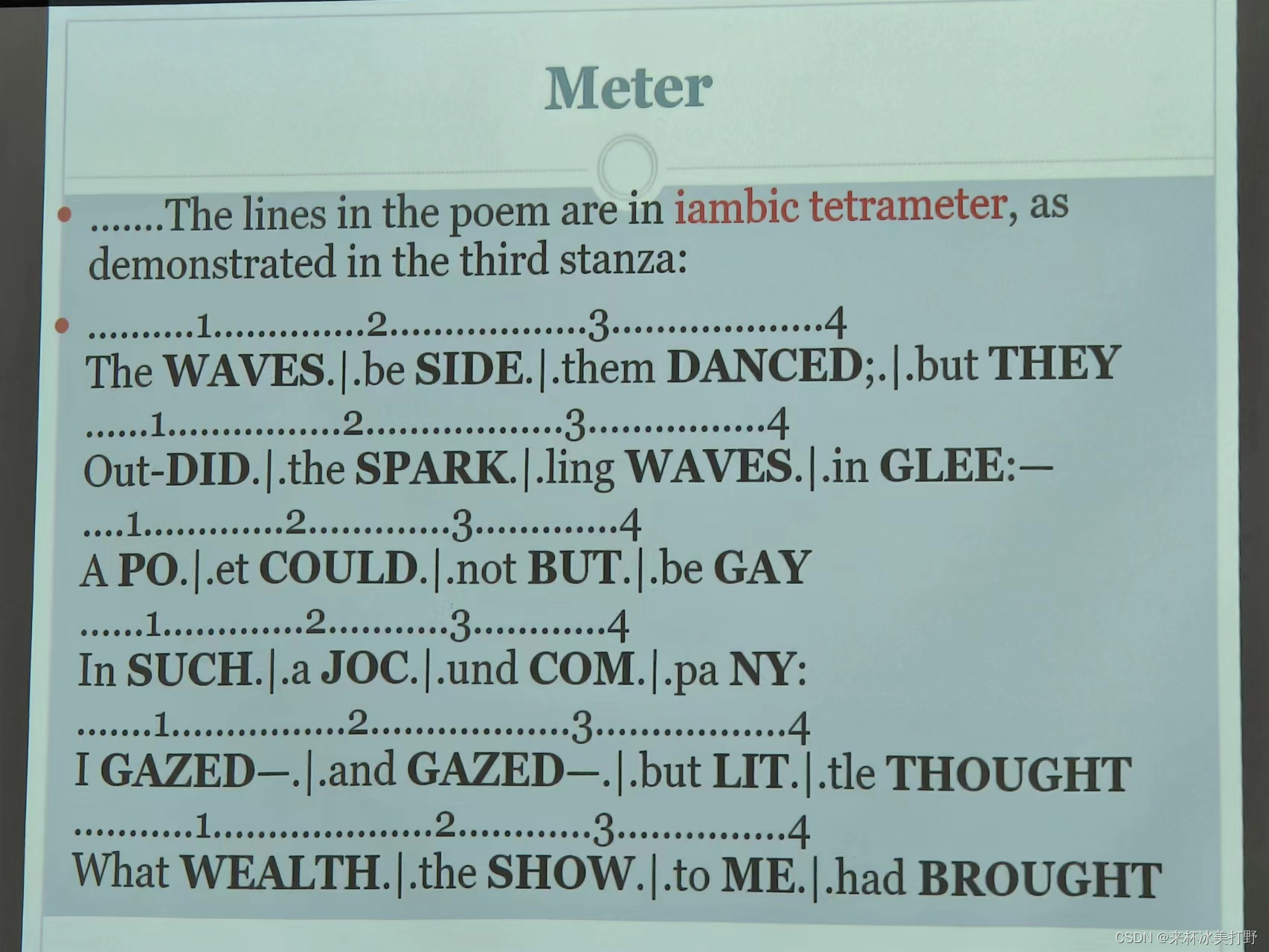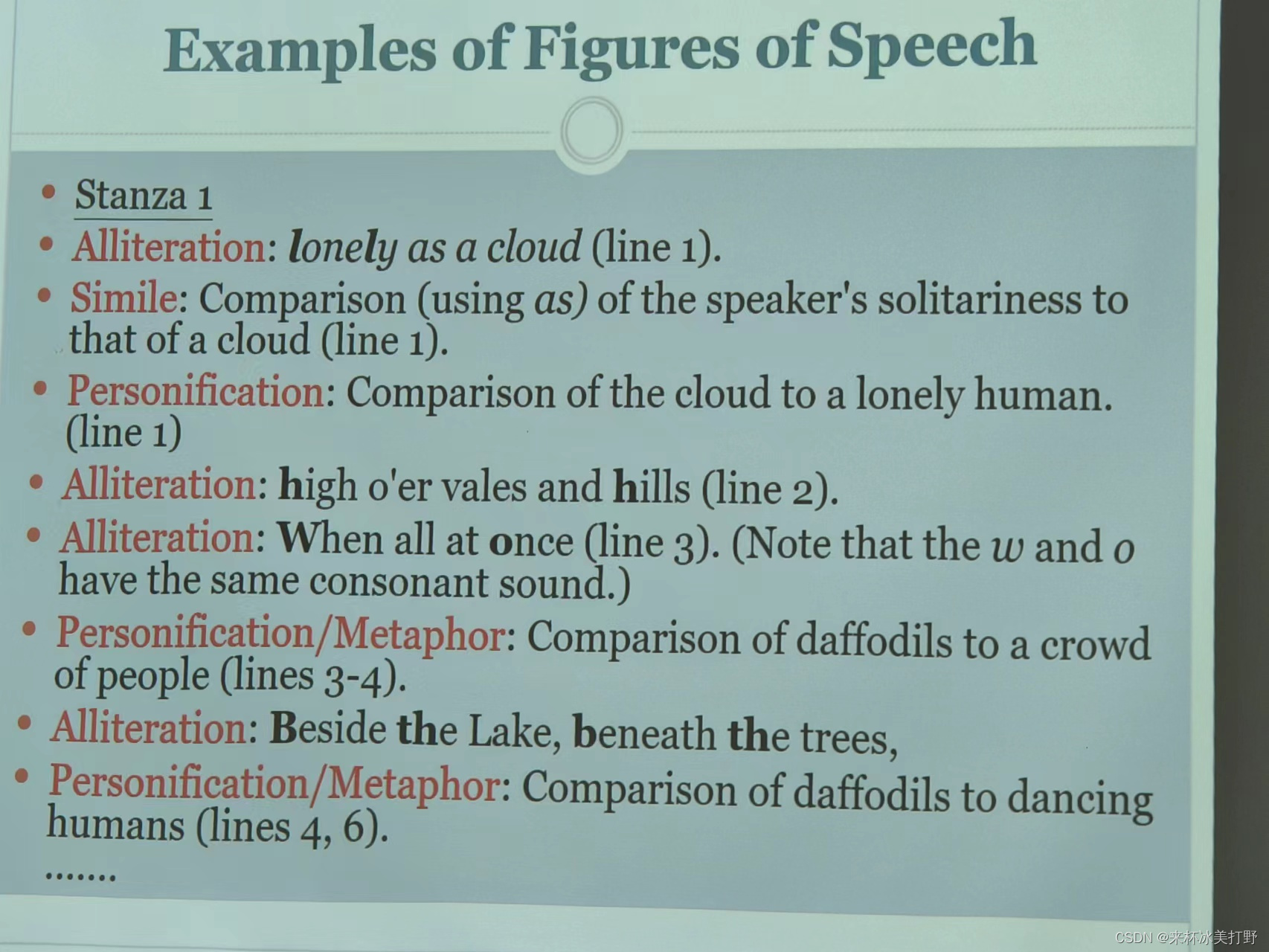| 广东外语外贸大学英语文学期末考试复习(解析+细节)2023 | 您所在的位置:网站首页 › 其他形式的文学作品英语怎么写 › 广东外语外贸大学英语文学期末考试复习(解析+细节)2023 |
广东外语外贸大学英语文学期末考试复习(解析+细节)2023
|
前言:本博客旨在以讲解的形式复习这门课程,非常详细,主要是个人复习用,也是给我比较喜欢的课一个好的结尾(虽然我不怎么去上课)。其中有不正确之处欢迎指正!翻译解读来自网易有道,文学术语解释来自chatgpt(3.5)及外网资料。如果你在看这篇博客复习,请务必提前写出你自己能答出来的答案再去考试。 抱着轻松的想法来看就好啦,祝你们秒过客观题,主观题下笔如有神! 大家好,本文已经全部更新完毕,祝大家考试顺利,武运昌隆! 有改正的我会在评论区改,评论区还有宝藏噢! 6.14最后一次更新日志!! 1.introduction中文 两分!加粗部分最后! 2.阿拉比ppt(感兴趣的自己看,谈恋爱要慎重) 3.韵律在最后! 4.破败王的台词:我那焦土一般破败的心啊!!! 5.无名之辈你是谁?我自己定义的答案用了明喻 应该用暗喻! 6.更新了韵律解读以及作者 7.更新大题解读 8.往年试卷选择题第三题3. The following poetic lines are divided into metric units by using the slash “/”, and the stressed syllables are capitalized while the unstressed syllables are written in small letters. Which of the following observations about these poetic lines is FALSE? 修改了这个诗的选项解释,感谢指正!这个诗段我们不学,下次有人学的话,请知道,这不是抑扬格,故答案选D。 佛耶戈_百度百科 (baidu.hk) 目录 1.讲师(王小东)所给复习提示(原文)以及原书introduction部分译文 introduction 2.考试题型 考试时长:90分钟 3.英语文学术语解释(form chatgpt3.5,先了解,个人建议红色的单词加深理解) 4.所需课文的逐篇理解分析 1.I am Nobody, Who are you? (recitation required)(背诵) 1.Symbol (象征): 2.Speaker (讲述者): 3.Theme (主题): 4.Tone (语气): 5.Rhyme (押韵): 6.Image (意象): 7.Word Choice (词语选择): 8.Figure of Speech (修辞手法): 9.Style (风格): 10.Setting (背景): 2.Theme for English B (Harlem Renaissance,美国种族歧视) 3.A Clean and Well-lighted Place 如:Narrator/ Theme/ Tone/ Symbol/ Image/ Figure of Speech/ Style/Setting/ Point of view/ Plot/ Conflict/character analysis/minimalism/theory of iceberg等 Narrator(叙述者): Theme(主题): Tone(语调): Symbol(象征): Image(意象): Figure of Speech(修辞手法): Style(风格): Setting(背景设置): Point of view(叙事视角): Plot(情节): Conflict(冲突): Character analysis(角色分析): Minimalism & theory of iceberg(极简主义和冰山理论): 4.The story of an hour (Feminism)女性主义 5.I Wandered Lonely as a Cloud (recitation required)(Romantism, 湖畔诗人) 《我孤独地漫步如云》的原文。 作者解读(关键词湖畔诗人) 浪漫主义 6.阿拉比 araby (麻木之城,顿悟) 1.(痛,太痛了!我那焦土一般破败的心那!原来爱,才是最深重的罪孽。每个男孩年轻的时候,都会迷恋一个女生,甚至把她看作goddess,但是经过顿悟后,男孩会变得更成熟。)先来看看这个故事讲了啥以及需要注意的细节。 建议先看原文,时间赶直接看中文,记住里面的主要人物!(死去的牧师,小男孩,曼根,叔叔阿姨,遗孀,市场里卖东西的人) 2.好的,看完了后先说一下这俩关键词是啥。(直接上个人理解,踩中点应该就有分 7.Sonnet 130 (recitation required)仅需背诵默写 5.2020年真题(与今年100%不同 只是检测复习用) I. Blank Filling(背就完了) II. Multiple Choice III. True or False IV. Short Questions(上强度了) V. Short Fiction Interpretation 6.韵律!!! 1.讲师(王小东)所给复习提示(原文)以及原书introduction部分译文*复习时需要掌握必读篇章的所有相关标红的文学术语对应细节。 1.I am Nobody, Who are you? (recitation required)(背诵) 如:Foot /Feet/ Symbol /Speaker/ Theme/ Tone/ Rhyme/ Image/word choice/ Figure of Speech/ Style/ Setting等 2.Theme for English B (Harlem Renaissance,美国种族歧视) 3.A Clean and Well-lighted Place 如:Narrator/ Theme/ Tone/ Symbol/ Image/ Figure of Speech/ Style/Setting/ Point of view/ Plot/ Conflict/character analysis/minimalism/theory of iceberg等 4.The story of an hour (Feminism) 5.I Wandered Lonely as a Cloud (recitation required) (Romantism, 湖畔诗人)(背诵) 6.Araby (麻木之城,顿悟) 7.Sonnet 130 (recitation required) 仅需背诵默写 Introduction (加粗部分两分)从广义上讲,文学包括任何被记录下来的东西。一个故事,一封信,一首歌,一份文件,一份调查,甚至一个数学问题都可以被称为文学。通常,人们倾向于在狭义上使用文学这个词。我们倾向于把实用作品排除在文学领域之外。一封信件、一份文件或一份调查报告,除非写得很好,从而获得某种审美价值,否则就不能成为文学。一个数学问题不太可能成为文学,除非它被一些作家在一些后现代写作实验中使用。从严格意义上讲,歌曲更接近文学,但同样,只有真正优秀的歌曲才被认为是真正的文学。 似乎是形式造就了文学。狭义的文学具有一种形式。在一定程度上,文学形式有助于创造审美价值,这使文学区别于其他主要是为了实用价值而阅读的作品。矛盾的是,传统的文学阅读主要关注文学作品的意义和内容,而不是形式。希腊哲学家柏拉图拒绝诗人进入他理想的共和国,因为诗歌“滋养和滋润激情”,在心中制造分裂和不稳定,或轻浮的笑声,并产生与公民美德相反的东西。在柏拉图、荷马、赫西奥德和其他戏剧家看来,他们没有把上帝描绘成善良的、一切美好的源泉,而是给了我们一群调情、争吵、欺骗、嫉妒和报复的神。柏拉图对诗人的态度表明,他主要关心的是诗歌和戏剧的内容。 柏拉图的学生亚里士多德也在同样的基础上惊叹于悲剧的巨大力量。对亚里士多德来说,悲剧的英雄必须是一个社会地位很高的人,悲剧的英雄必须有一个命运的转变(从繁荣到灾难)。所以当观众看到一个伟大的人从繁荣到默默无闻,他们震惊地思考自己的命运,并产生了巨大的宣泄力量。虽然柏拉图和亚里士多德都认为伟大的权力(污染的权力或净化的权力)离不开某种形式的帮助,但内容是他们最关心的。这种对待文学的态度一直延续到今天。为了意义而阅读仍然是大多数人的做法。 对一些人来说,文学和其他艺术形式的价值不在于内容而在于形式。正如圣经所说:“日光之下并无新事。”我们可能已经听过或经历过同样的故事很多次了,却没有注意到它。但是,当同样的故事以某种文学形式呈现时,它就变成了不同的东西。产生了一定的距离或意识。虽然这个故事听起来很熟悉,但它有一些新的东西,一些令人兴奋的东西,以及一些不确定的东西。我们被迫以不同的方式看待旧故事,熟悉的故事变得陌生。因此,我们变得更好奇,更敏感。 同样的神奇也发生在其他形式的艺术上。一双鞋是一种熟悉的景象,熟悉到我们常常分不清谁是谁。但当我们看到它出现在文森特·梵高(Vincent van Gogh)的油画中时(见附图),我们会感到震惊。我们对它的大小感到震惊。看颜色,看粗糙的皮,看鞋带缠结的方式。我们对它的每一个细节都感到震惊。 我们想知道它的历史,它的主人,它走过的旅程等等。一双鞋不再是一双鞋了。它成为人们极大兴趣的对象,成为沉思的对象,成为想象的源泉。它的呈现方式和形式为它创造了意义。 世界充满了事物,但大多数时候,我们看不到它们。为了让人们看到事物,艺术家将事物陌生感(用不寻常的形式解开它们),让人们觉得自己是第一次看到这些事物。他们的眼睛变得好奇,感觉敏锐,反应强烈。从这个意义上说,艺术不仅使物复活,而且使人复活。因为艺术,事物才开始存在。因为艺术,人类重生为婴儿。世界是全新的,等待着他们的发现。由于人们很快就会习惯一种艺术形式,他们的眼睛又瞎了,他们的感官迟钝了,艺术必须永远创新。一种艺术形式很快被另一种艺术形式所取代,以确保陌生感。 所以,除了读文学的内容,我们也应该读文学的形式。采用什么形式?形式如何增强意义,创造意义?取得了什么效果?创造了什么意义?由于陌生化效应,我们获得了什么新的视角?我们喜欢这种新的观点吗?文学形式包括结构、叙述、语言、音乐等元素。 尽管如此,文学作品还是可以从批判的角度来解读。在这种立场下,人们阅读文学是为了批评文学中某些问题的处理方式。批判方法的共同问题是:性别问题、种族问题和社会问题。对于性别问题,人们通过阅读来了解女性在文学作品中的表现。与男性角色相比,女性角色相对重要还是不重要?他们是否处于顺从的地位?他们是被扭曲了还是只是刻板印象?写作的语言是男性主导的吗?或者评论家们阅读女性作家的作品是为了展示女性作家是如何在一个男性主导的社会中写作的,或者是为了展示女性看待世界的视角,或者是为了发现在语言、情感或视角方面,什么是女性特有的。对于种族问题,人们提出了类似的问题:某些种族在文学中被忽视或不公正对待了吗?某个种族的形象是否被扭曲或定型?语气对某个种族是有利的还是不利的?如果我们把内容阅读称为情感阅读和说教阅读,把形式阅读称为审美阅读,那么这种文学阅读方式就可以称为政治阅读。这种方法很受有政治意识或对某些问题感兴趣的人的欢迎。 When people read literature for its meaning, for its form or for a political purpose, theypresuppose that the structure of the literary work is stable and thus what is revealed is relatively stabletoo. What if the stability of the structure itself is to be doubted? ls there any definite meaning then?This is the poststructuralist stance to a literary work. The poststructuralists think that the structure ofthe literary work is not solid but a chain of signs with no sign dominating the other. When you startdefining one sign, you have to use other signs which again need to be defined. You start a chain ofinfinite meanings. Like waves stirred by a stone, meaning is forever diffusing and expanding, evadingyour grasp. In this sense, the poststructuralists declare the “death of the author”. Since languageand the so-called meaning produced by language refuse to be controlled, the author has no authorityover his work anymore. Meaning becomes the interaction between the text and the reader for a shorttime being. The reader has to arbitrarily cut the flow of meaning for a moment and get a relativelystable meaning for a time being. So in a sense, it is both the author and the reader that create meaningtogether. 当人们为了其意义、形式或政治目的而阅读文学作品时,他们预设文学作品的结构是稳定的,因此所揭示的内容也相对稳定。如果结构本身的稳定性受到怀疑怎么办?那有什么明确的含义吗?这是文学作品的后结构主义立场。后结构主义者认为,文学作品的结构不是坚固的,而是一连串的符号,没有一个符号支配着另一个符号。当你开始定义一个符号时,你必须使用其他需要定义的符号。你开启了无限意义的链条。就像石头激起的波浪一样,意义永远在扩散和扩展,逃避你的把握。从这个意义上说,后结构主义者宣告了“作者的死亡”。由于语言和语言产生的所谓意义拒绝被控制,作者对自己的作品不再有权威。意义在短时间内成为文本与读者之间的互动。读者必须在某一时刻随意切断意思的流动,暂时得到一个相对稳定的意思。所以从某种意义上说,是作者和读者共同创造了意义。 Poststructural reading, like poststructual writing, is interesting as a radical experiment, arevolution against the traditional way of thinking. As anything that is radical, it can't hold thedominant position. For most readers and critics, literature has a stable structure, from where they canread for content, read for form and read for discussing problems. 后结构主义阅读和后结构主义写作一样,作为一种激进的实验,对传统思维方式进行了一场革命,这是很有趣的。然而,像任何激进的观点一样,它无法保持主导地位。对于大多数读者和评论家来说,文学具有稳定的结构,从这个结构中他们可以阅读内容,阅读形式,并进行问题讨论。
解析:1.背诵填空 2.多项选择 3.注意书里的introduction部分,有文学理论,下文介绍 4.理解课文 5.最难的部分 如何分析课本外的文学作品?所给提示:海明威的冰山理论和电报风格 下面是两个理论的解析https://zhuanlan.zhihu.com/p/39994665 冰山理论(Hemingway's iceberg theory):即写作只表现海面上的部分,而海面以下的八分之七需要读者细心研读文本,才能体会其中的意蕴。海明威在创作时只写出了故事的冰山一角,让读者自行想象接下来的内容。这使得读者愿意通过想象,更好地了解其作品中想要表达的思想。我们中文常说的“留白”也是一样的道理。 电报风格(telegraphic style):(这里和老师交谈时得知应该是一个文本简单理论,即文本要接地气,推断得出是海明威的电报风格,请知道的同学补充)“电报式”风格,也就是追求语言的简洁,这有利于读者阅读他所写的故事,不会因为深奥的语言而与读者产生距离。海明威的电报风格是指他在写作中使用简洁、精炼和直接的语言风格,类似于电报传递信息的简明扼要。他倾向于使用简短的句子和词汇,避免冗长的修饰和多余的描写,以达到简洁明了的效果。海明威强调通过简洁的语言传达情感和意义,让读者通过自己的感知和体验来理解和感受故事。这种电报风格的写作被认为是他的独特风格之一,也是他对现代文学的重要影响之一。 oh,看来是回答极简主义,把极简主义替换掉这个电报就行。minimalism 极简主义 根据所给提示以及考试要求推断:应该是围绕这两个理论以及下文的部分学术语写两篇简单的分析文章,即可拿到不错的分数。(尽量用自己会的词语和表达,以及记住下文英语文学术语中标红词,不要想着花里胡哨的表达!) 3.英语文学术语解释(form chatgpt3.5,先了解,个人建议红色的单词加深理解)当然!我很愿意帮助您解释这些英语文学术语。以下是对每个术语的简要解释: Allegory(寓言):通过使用符号和象征手法来表达抽象概念或思想的故事,通常有隐含的寓意。 Alliteration(头韵):在一句话或一段文字中,重复相邻的词或音节的首字母或辅音音素,以增强修辞效果和韵律。 Anaphora(排比句):在连续的句子或诗句中,重复使用相同的词或短语作为开头,以强调和增加修辞效果。 Anastrophe(倒装):改变语序,将语法正常顺序颠倒,以产生强调效果或修辞效果。 Assonance(同音):在一句话或一段文字中,重复相邻的词或音节的元音音素,以增加韵律和声音的重复效果。 Climax(高潮):故事或文学作品中的最高点或最关键的瞬间,通常是紧张或引人入胜的部分。 Conflict(冲突):故事中的对立或矛盾,可能是人与人之间、人与自然或人与自身之间的冲突。 Consonance(谐音):在一句话或一段文字中,重复相邻的词或音节的辅音音素,以产生韵律和声音的重复效果。 Couplet(对联):两行连续的韵文,通常长度相等,押韵方式相同。 Enjambment(跨行):在诗歌中,一行的句子延伸到下一行而没有停顿或断开,使句子流畅地跨越多行。 Existentialism(存在主义):一种哲学和文学思潮,关注人类的自由意志、存在的意义和个体责任。 Figure of Speech(修辞手法):在文学中使用的表达形式,以创造形象、增强意义或产生比喻。 Foot and Feet(音步和音节):诗歌中的基本韵律单位,由一个或多个音节组成。 Free Verse(自由诗):没有固定的节奏、韵律或押韵规则的诗歌形式。 Genre(文体):文学作品按照主题、风格或形式进行分类的方式。 Hyperbole(夸张法):通过夸大表达来强调某个概念或情感的修辞手法,常用于诗歌、故事或口语中。 Image(意象):通过生动的语言描述或比喻,呈现出视觉、感官或情感上的形象,以增强读者的感受和理解。 Irony(讽刺):通过使用与表面意义相反或出乎意料的语言表达,以传达一种隐含的意义或达到幽默、嘲讽或批评的效果。 Metaphor(隐喻):通过将一个事物或概念与另一个不相关的事物进行比较,以便传达隐含的相似性或共同点。 Narrator(叙述者):讲述故事的人物或声音,可以是第一人称(以"我"的身份叙述)或第三人称(以观察者的角色叙述)。 Narration(叙事):故事的讲述方式或过程,包括叙述的角度、时间顺序和叙述者的语气等。 Naturalism(自然主义):一种文学和艺术运动,强调人类行为受遗传和环境因素影响,强调真实、客观和科学观察。 Personification(拟人):赋予非人类事物或抽象概念人类的特征和行为的修辞手法。 Plot(情节):故事中事件发展的安排和结构,包括起始、发展、高潮和结局。 Poetry(诗歌):使用有节奏、韵律和押韵的语言来表达情感、思想和意象的文学形式。 Point of view(视角):故事或文学作品中叙述者或人物的观察和思考角度。 Quatrain(四行诗节):由四行组成的诗节,可以有不同的韵律和押韵模式。 Rhyme(押韵):诗歌中相邻的词或音节以相似的音韵重复,以增加声音的和谐和韵律。 Setting(背景):故事发生的时间、地点和环境背景。 Simile(明喻):通过使用"像"或"如同"等比较词语来将两个不同的事物进行比较,以便传达相似之处。 Speaker(说话者):诗歌或文学作品中的声音来源,可以是作者本人或者是虚构的人物,通过说话者的视角来传达情感、思想或故事。 Stream of Consciousness(意识流):一种文学技巧,通过模拟人类思维的连续和非线性方式来呈现人物内心的想法、感觉和意识活动。 Style(风格):作者的独特写作方式和表达方式,包括词汇选择、句法结构、语言节奏等,用于传达情感和主题。 Symbol(象征):代表着抽象概念、思想或价值观的具体事物、动作或符号,通过象征意义来传达深层含义。 The Music of Poetry(诗歌的音乐):诗歌中由韵律、音调和声音的组合所创造的美感和节奏感。 Theme(主题):文学作品中的核心思想、中心议题或主要观点,通常是作品所探讨的普遍或深刻的问题。 Tone(语气):作者在作品中表达情感和态度的方式,可以是喜悦、愤怒、哀伤等,通过语气传达作者的立场和情绪。 4.所需课文的逐篇理解分析 1.I am Nobody, Who are you? (recitation required)(背诵)
艾米莉·狄金森(Emily Dickinson,1830-1886年)于1830年12月10日出生在马萨诸塞州安赫斯特。艾米莉一直隐居在她出生的房子里,除了短暂的时间在安赫斯特学院和霍利克女子学院就读,直到她去世。她的十首诗歌在她的一生中发表。如今,艾米莉·狄金森被普遍认可为一位卓越的诗人。她奇特而独创的诗歌帮助开创了现代诗歌。
I'm nobody!Who are you? 我是无名之辈,你是谁? Are younobody, too? 你也是无名之辈? Then there's a pair of us--don't tell! 那咱俩就成了一对——别出声! They'd banishi us, you know! banish v.驱逐,赶走;将……驱逐出境,流放;清除,消除;打消……的念头,驱除(想法)他们会排挤咱们——要小心! How dreary to be somebody! dreary adj.沉闷的,令人沮丧的做个大人物多没劲! How public, like a frog, 多招摇——像只青蛙 To tell your name the livelong day, 对着欣赏的小水洼 To an admiring bog! 整日里炫耀自己的名号! 解析:根据和老师的交谈,本诗应该不考韵律,(老师的提示是:其实不怎么考,韵律部分应该关注那个I Wandered Lonely as a Cloud ,那我在此简单post一些理解)要赶着考试的请直接背加粗字体。 1.Symbol (象征):The word "Nobody" in the poem serves as a symbol. It represents the rejection of societal expectations and the desire for individuality and freedom. It symbolizes a sense of liberation from the pressures of conforming to social norms and seeking fame or recognition. (诗中的词语"Nobody"充当了一个象征。它代表了对社会期望的拒绝,表达了追求个体独立和自由的愿望。它象征着解脱于社会规范和追求名誉或认可的压力之外的自由感。) 2.Speaker (讲述者):The author counterfeits the speech of a person in a particular situation.Emily Dickinson invented an "I” who prefers to be "Nobody". We call "I” the speaker in the poem rather than the poetess herself. (作者伪造了一个特定情境中的人的言语。艾米莉·狄金森创造了一个偏爱成为 "Nobody" 的 "我"。我们称 "我" 为诗歌中的讲述者,而不是诗人本人。) 3.Theme (主题):The theme of the poem revolves around the contrast between individual identity and societal expectations. It explores the idea of being an outsider, choosing anonymity over conformity, and questioning the value of fame and attention. (这首诗的主题围绕个体身份与社会期望之间的对比展开。它探讨了成为局外人的想法,选择匿名而不是顺应常规,并质疑名誉和关注的价值。) 4.Tone (语气):The tone of "I'm Nobody! Who are you?" is playful, humorous, and slightly ironic. The speaker adopts a light-hearted and teasing tone, challenging the reader to admit if they too are "Nobody." The tone contributes to the overall satirical and critical nature of the poem. ( "I'm Nobody! Who are you?"的语气是轻松、幽默且稍带讽刺。讲述者采用了轻松愉快而揶揄的语气,挑战读者承认他们是否也是"Nobody"。语气有助于整体的讽刺和批判性。) 5.Rhyme (押韵):The poem utilizes a simple rhyming pattern, with a consistent end rhyme scheme of AABB. For example, "you" and "too" rhyme in the first stanza. (这首诗采用简单的押韵形式,具有一致的押韵方案AABB。例如,第一节中的"you"和"too"押韵。) 6.Image (意象):The imagery in the poem "I'm Nobody! Who are you?" is portrayed through concise and vivid language, such as the contrasting imagery between "Nobody" and "Somebody," as well as the imagery of the "Frog" and the "Bog." 在诗歌 "I'm Nobody! Who are you?" 中的意象通过简洁而生动的语言来描绘,例如 "Nobody" 和 "Somebody" 之间的对比意象,以及 "Frog" 和 "Bog" 的意象。 The contrast between "Nobody" and "Somebody" serves as a metaphorical imagery representing the difference in societal status and recognition. "Nobody" implies a person who is unnoticed and anonymous, while "Somebody" suggests someone who is noticed and respected. This juxtaposition helps the poet convey a rejection of societal expectations and a pursuit of individuality. "Nobody" 和 "Somebody" 之间的对比象征着社会地位和认可的差异。"Nobody" 暗示了一个不被注意和匿名的人,而 "Somebody" 则暗示着一个被注意和尊重的人。这种并列帮助诗人传达了对社会期望的拒绝和对个体独立的追求。 那么很简单,frog就是指那些大声叫的人,谋取名誉和社会关注,"Bog"(泥沼)则是另一个象征性的意象,它代表着一个湿润、泥泞、难以通过的地方。泥沼可以被视为一种陷阱或束缚,暗示着被困住、埋没或被忽视的状态。在诗中,"Bog" 可以象征着社会压力、被规范束缚和无法自由表达自我的环境。但是我更倾向于说,他们那些Somebody也是容易被困住的。考试问到了,就这样回答,直接照抄我的: The images in this poem are:Somebody, Nobody, Frog and Bog. "Nobody" implies a person who is unnoticed and anonymous, while "Somebody" suggests someone who is noticed and respected. (太简单不翻译) The frog symbolizes those who make noise in their pursuit of fame and reputation, while the bog represents the trap or dilemma that fame itself can easily lead to. 青蛙是指那些发声而谋求名誉的人,小水洼是指声名其实是一种容易陷入的困境。 7.Word Choice (词语选择):The poet employs concise and straightforward language throughout the poem. The choice of words is deliberate, aiming for clarity and impact, while maintaining a conversational tone. (诗人在整首诗中运用简洁而直接的语言。词语的选择是有意为之,旨在清晰有力地表达,并保持谈话的语气。) 其实直接答第六问,再加一个电报理论就可以了,我请你自己写一个你自己考试可以简答出来的版本。实在不行就背上面的吧。 8.Figure of Speech (修辞手法):While the poem does not heavily employ figurative language, it does employ a mild form of irony and satire to convey its message. The use of the question "Who are you?" creates an element of rhetorical questioning and invites reflection. (虽然诗中没有大量使用修辞手法,但它运用了一种轻微的讽刺和讽喻,以传达其信息。提问"Who are you?"创造了一种修辞疑问的元素,并引发了反思。) 请记住这个讽刺和隐喻,我觉得可以写个比喻(Simile)也行(不对不对,暗喻暗喻!!!),比如把somebody比作frog。(而他们也有可能只能看见和被困在一个小水洼中) 上面不应该用明喻,用这个词Metaphor!!! 9.Style (风格):The poem showcases a concise and direct style, characteristic of Emily Dickinson's writing. It demonstrates her ability to convey profound ideas using minimal words and simple language. (这首诗展示了简洁明了、直接的风格,这是艾米莉·狄金森写作的特点。它展示了她用最少的词语和简单的语言表达深刻思想的能力。) 10.Setting (背景):这个作者本来就是一个比较自闭的人,她以前是一个社交大牛,也很多人追,谈了几段小恋爱。后来喜欢把自己关在房间里面读书和写诗,这篇诗也应该确实没有什么背景,那么答案也就是直接写作者本人的状态就好了。(题外话,老师好像上课说她爹去世后她就更加自闭了,但是我查了她爸爸还在世的时候她就写了这个诗。) 先来看看这首诗在书里面的FOCUS吧
LITERARY FOCUS The Speaker and the Poet or Author The speaker is the voice, or mask or persona (Latin for "mask") that speaks the poem. It is usually not identical with the poet or author who writes it. The author counterfeits the speech of a person in a particular situation. Emily Dickinson invented an "I” who prefers to be "Nobody". We call "I” the speaker in the poem rather than the poetess herself. The speaker's voice does often have the ring of the poet or the author's own voice, and to make a distinction between speaker and poet or author may at times seem perverse, because some poetry (especially contemporary poetry) is highly autobiographical. Still, even in autobiographical poems it may be convenient to distinguish between poet or author and speaker: the speaker is Emily the lonely woman, or Emily the curious and naughty woman, not simply Emily the poetess. 说话者和诗人或作者 说话者是诗歌中的声音,或者是面具或角色(拉丁语为 "面具"),ta说出了这首诗。通常,它与撰写诗歌的诗人或作者并不完全相同。作者伪造了一个特定情境中的人的言语。艾米莉·狄金森创造了一个偏爱成为 "Nobody" 的 "我"。我们称 "我" 为诗歌中的说话者,而不是诗人本人。说话者的声音通常具有诗人或作者自己的声音特点,而在说话者和诗人或作者之间进行区分有时可能显得反常,因为一些诗歌(尤其是当代诗歌)是高度自传性的。尽管如此,即使在自传诗中,区分诗人或作者和说话者可能是方便的:说话者是孤独的女人艾米莉,或者是好奇而淘气的女人艾米莉,而不仅仅是诗人艾米莉。 这个FOCUS更关注于speaker的部分,答案在上面 现在我们可以组织setting的答案了,keywords:room,express,outsider,nobody,reflect Emily Dickinson enjoyed writing poetry in her room, where she would explore her inner world and express criticism and reflection on the external world. She is an outsider, also the Nobody. She written this poetry to express herself.(很简单很好写) 6.13补充:往年题的问法是问images和setting。详情见下文往年题。
加上frog 和bog 解释一下,再加上这句出现在往年题里的话,就ok了
兰斯顿·休斯(1902-1967)是哈莱姆文艺复兴运动中最重要的作家和思想家之一。哈莱姆文艺复兴运动是20世纪20年代颂扬黑人生活和文化的非裔美国人艺术运动。他的文学作品帮助塑造了美国文学和政治。休斯和其他活跃在哈莱姆文艺复兴运动中的人一样,有着强烈的种族自豪感。通过他的诗歌、小说、戏剧、散文和儿童读物,他提倡平等,谴责种族主义和不公正,颂扬非裔美国人的文化、幽默和精神。 原文太长不放了,自己看书。 给点解释:(重点看这个) 《Theme for English B》是由Langston Hughes创作的一首诗歌,它的写作背景可以与哈莱姆文艺复兴和美国的种族歧视问题联系起来。 在哈莱姆文艺复兴时期,非裔美国人文化和艺术经历了巨大的发展和突破。这个时期,非裔作家和诗人们开始在自己的作品中探索种族和身份问题,表达他们对美国社会中存在的种族不平等和歧视的关注。他们试图通过文学和艺术为非裔美国人争取平等权利,反映他们的经验和声音。 在《Theme for English B》中,诗人通过描述一个非裔学生在英语作业中的内心挣扎和思考,探讨了种族和文化对个人身份的影响。诗中的主人公是一个哈莱姆的年轻学生,他被要求写一篇关于自己的英语作业。这个诗人通过对自己的思考和内心独白,表达了他作为一个非裔学生的独特经历和观点。 这首诗反映了美国社会中的种族歧视和对非裔美国人的限制。诗中的主人公意识到自己与白人教师和同学之间的不同,并思考了自己的身份和自我认同。通过这首诗,Langston Hughes以个人的经历和声音,呼吁对种族平等和文化多样性进行思考和讨论。 因此,写作背景中的哈莱姆文艺复兴和美国的种族歧视问题对《Theme for English B》的创作产生了深远的影响,使诗人能够表达自己的观点,并为非裔美国人争取平等的权利和认可。 考试提示主题解释:(了解即可) 哈莱姆文艺复兴(Harlem Renaissance)是指20世纪20年代至30年代期间,发生在美国纽约哈莱姆区(Harlem)的一场文化、社会和艺术运动。这个时期,哈莱姆区成为了非裔美国人的文化和艺术中心,吸引了许多才华横溢的非裔作家、艺术家、音乐家和思想家。 哈莱姆文艺复兴是非裔美国人在创作领域取得重要突破和认可的重要时期。在这个时期,非裔作家和诗人们通过他们的作品表达了非裔美国人的经历、文化、挣扎和梦想。他们的作品探索了种族、身份、社会不平等和黑人文化的问题,为非裔美国人争取平等权利做出了积极的贡献。 哈莱姆文艺复兴不仅仅涵盖了文学领域,还包括音乐、舞蹈、绘画和戏剧等艺术形式。爵士乐成为了这一时期的代表性音乐,非裔美国人音乐家们通过创作出独特的音乐风格,为哈莱姆文艺复兴增添了活力和影响力。 这场文化运动在当时对美国社会产生了深远的影响,不仅提升了非裔美国人的文化自豪感和自尊心,也推动了种族平等和文化多样性的讨论。哈莱姆文艺复兴被视为美国文化史上的重要里程碑,对现代美国文学和艺术产生了长远的影响。(好!没有这个就没有后面的黑人音乐rap和rnb,还有迈尔斯蜘蛛侠!不歧视黑人,只歧视违法犯罪和在中国利用黑人身份获得便利和特权的黑哥。) 美国种族歧视不解释了,白人3k党,还有跪压事件和黑命贵,都说明黑人是被歧视的。感兴趣的可以看一下新闻,这里踩一脚电影绿皮书,推荐歌曲this is America的mv。最讽刺的是,我喜欢的xxx为黑人发声,却被俩黑人抢劫枪击了。 既然这样给提示词,那么想必问题就是问这首诗的背景Setting了,如果在选择题出现直接回答关键词即可,如果在简答题中出现,那也是答关键词,但是要组织一下。其他关于本课文的解析请自己上网查。简答题答案如下,把黑体写上就行: The writing background of this poem is the Harlem Renaissance and racial discrimination in America. The poet explores the influence of race and culture on personal identity by depicting the inner struggles and reflections of an African-American student in an English assignment. It expresses the poet's unique experiences and perspectives as an African-American student. He hoped that Black culture can also integrate(融合) with mainstream culture. 本文的写作背景是哈莱姆文艺复兴和美国种族歧视,诗人通过描述一个非裔学生在英语作业中的内心挣扎和思考,探讨了种族和文化对个人身份的影响,表达了他作为一个非裔学生的独特经历和观点。希望黑人文化也能和主流文化融合。 3.A Clean and Well-lighted Place 如:Narrator/ Theme/ Tone/ Symbol/ Image/ Figure of Speech/ Style/Setting/ Point of view/ Plot/ Conflict/character analysis/minimalism/theory of iceberg等注:老师强调期末无关sexual和politic 所以在此不对本诗讨论这些话题 (6.13补充):2020年考试试卷出现了关于文章细节的考察,所以在这里补充中文链接,下面的文章亦同。 一个干净明亮的地方(原文、译文)/海明威 - 知乎 (zhihu.com)
欧内斯特·米勒·海明威(Ernest Miller Hemingway,1899-1961)是一位美国小说家、短篇小说作家和记者。他独特的写作风格以简洁和含蓄为特点,并对20世纪小说写作的发展产生了重要影响。海明威的主人公通常是坚忍的人,常被视为他自己性格的投射,这些人必须在压力下展现“优雅”。他的许多作品被认为是美国文学经典,例如《太阳照样升起》(1926年)、《永别了,武器》(1929年)、《丧钟为谁而鸣》(1940年)、《老人与海》(1952年)。他拿过诺贝尔奖呀! Narrator(叙述者):The story is narrated in the third person by an omniscient narrator. This allows the reader to have access to the thoughts and perspectives of multiple characters.这个故事以第三人称的方式由一个全知的叙述者进行叙述。这使得读者可以了解到多个角色的想法和观点。 Theme(主题):The theme of the story revolves around the existential emptiness and despair experienced by individuals in a seemingly meaningless world. 这个故事的主题围绕着个体在一个看似毫无意义的世界中所经历的存在主义的空虚与绝望。 Tone(语调):The tone of the story is somber and melancholic. Hemingway's concise and understated writing style contributes to a sense of emotional detachment and resignation, reflecting the characters' disillusionment with life. 这个故事的语调沉郁而忧伤。海明威简练而含蓄的写作风格使得情感的冷漠和顺从感更加明显,反映了角色们对生活的幻灭。 Symbol(象征):The café in the story serves as a symbol of refuge and solace in the face of the existential void. It represents a clean, well-lighted place where characters can momentarily escape their loneliness and despair. The café symbolizes a temporary respite from the darkness and uncertainty of the outside world. 故事中的咖啡馆象征着在存在主义虚无面前的庇护和安慰。它代表着一个干净明亮的地方,人们可以暂时逃离他们的孤独和绝望。咖啡馆象征着对外界黑暗和不确定性的暂时喘息。 Image(意象):The imagery in the story is sparse yet evocative. Hemingway's use of simple and concrete descriptions creates a vivid sense of place and atmosphere. For example, the imagery of the old waiter's insomnia and his "nada" speech adds to the story's existential themes. 故事中的意象虽然简约但富有感染力。海明威简洁具体的描写创造了一个生动的地点和氛围。例如,老侍者失眠和他的“nada”演讲的意象增强了故事的存在主义主题。 Figure of Speech(修辞手法):One figure of speech used in the story is metaphor. The older waiter, when describing the cafe, refers to it as a "clean, well-lighted" place. This metaphor emphasizes the desire for order and comfort in an otherwise chaotic and disorienting world. 故事中使用的修辞手法之一是隐喻。老侍者在描述咖啡馆时称其为一个“干净明亮的”地方。这个隐喻强调了在一个混乱和迷失的世界中对秩序和舒适的渴望。 Style(风格):Hemingway's writing style is characterized by minimalism, often referred to as the "iceberg theory" or "theory of omission." He omits explicit details and focuses on the surface-level events, leaving much unsaid and allowing readers to infer deeper meanings. This style contributes to the story's sense of ambiguity and invites readers to engage actively in the interpretation of the narrative. 海明威的写作风格以极简主义为特点,通常被称为“冰山理论”或“遗漏理论”。他省略了明确的细节,关注表面上的事件,留下了许多未说的话,使读者可以推测更深层次的含义。这种风格增加了故事中的歧义感,并邀请读者积极参与叙事的解释。 Setting(背景设置):The setting of the story is a café late at night. The quiet and empty environment creates a sense of isolation and contemplation. The contrast between the bright, well-lit café and the darkness outside further emphasizes the theme of finding solace in a world that feels cold and indifferent. 故事的背景是一个深夜的咖啡馆。安静而空旷的环境营造出孤独和思考的感觉。咖啡馆明亮而整洁的对比强调了在一个感觉冷漠和漠不关心的世界中寻求安慰的主题。 Point of view(叙事视角):The story is told from an objective point of view, allowing readers to observe the characters' actions and listen to their thoughts. This perspective adds to the sense of detachment and universality of the story's themes. 这个故事以客观的视角叙述,使读者能够观察角色的行动并倾听他们的思绪。这个视角增加了故事的冷漠感和普遍性。 Plot(情节):The plot centers around a conversation between two waiters and an old deaf man who drinks alone in the café. The conflict emerges from the characters' differing perspectives on the meaning of life and the ways they cope with existential despair. The younger waiter is dismissive and lacks empathy, while the older waiter demonstrates compassion and a deeper understanding of human suffering. 情节围绕着两名侍者和一个老聋人在咖啡馆独自饮酒的对话展开。冲突源于角色对生命意义和应对存在主义绝望的方式有不同的看法。年轻的侍者傲慢而缺乏同理心,而老侍者则表现出同情心和对人类苦难的更深层次的理解。 Conflict(冲突):
根据和老师的交谈以及课件,冲突主要由这四个元素来表现,写出黑体字即可 Dissatisfaction(不满):故事中的年轻服务员和老服务员对生活有不同的态度和观点。年轻服务员对老人的孤独和无聊感到不耐烦,他想早点关闭咖啡馆回家。而老服务员对于年轻服务员的态度感到不满,他更加理解和同情老人的心情,并希望提供一个安静舒适的环境给他们。The young waiter and the old waiter have different attitudes and perspectives towards life. The young waiter becomes impatient with the old man's loneliness and boredom, wanting to close the café and go home early. The old waiter, on the other hand, is dissatisfied with the young waiter's attitude. He understands and sympathizes more with the old man's feelings and wishes to provide a quiet and comfortable environment for them. Mortality(死亡):老人在故事中象征着孤独和绝望的存在。他们频繁光顾这个咖啡馆,寻找一种逃离孤独的方式。老人们感受到时间的流逝和自己生命的有限性,这种存在对他们来说是一种折磨和冲突。Mortality: The old men in the story symbolize the existence of loneliness and despair. They frequent the café, seeking a way to escape their solitude. The passage of time and the finite nature of their lives torment them, creating a conflict within them. Alcohol(酒精):酒精在故事中是一种逃避现实和平静内心的方式。老人们在咖啡馆里喝酒,以此麻痹自己对孤独和绝望的感受。酒精成为他们暂时摆脱内心冲突的手段。Alcohol serves as a means of escaping reality and finding inner peace in the story. The old men drink in the café, using alcohol as a temporary numbing agent for their feelings of loneliness and despair. Alcohol becomes a way for them to momentarily alleviate their internal conflicts. Old Age(年老):年老是故事中的一个重要主题,与孤独、无聊和绝望紧密相连。老人们在故事中感受到年老带来的失落和无助,他们渴望找到一个干净明亮的地方,以在暂时的宁静中逃离内心的痛苦。Old age is a significant theme in the story, closely linked to loneliness, boredom, and despair. The old men experience feelings of loss and helplessness associated with aging. They seek for a clean, well-lighted place to momentarily escape the pain within themselves. 总结:老人也有不满 但是无需回答,只要答年轻人的不耐烦和年长侍者对年轻人的不满即可。 老人就是孤独和绝望,通过酒精麻痹和逃避,寻求一个干净明亮的地方也是逃避痛苦。 key words:Dissatisfaction,impatient,loneliness and despair,loss,escape,feeling. Character analysis(角色分析):In terms of character analysis, the two waiters represent different attitudes toward life. The older waiter, who understands the loneliness and despair that plague humanity, exhibits empathy and compassion. In contrast, the younger waiter is more self-centered and lacks understanding of the older man's struggles. 在角色分析方面,这两个侍者代表着对生活持不同态度。老侍者了解孤独和绝望困扰人类,表现出同情心和对人类苦难的更深层次的理解。相比之下,年轻的侍者更加以自我为中心,缺乏对老人困境的理解。 Minimalism & theory of iceberg(极简主义和冰山理论):Concise language: Hemingway is known for his concise and straightforward writing style. His sentences are short and to the point, avoiding ornate rhetoric and unnecessary words. In this story, he employs succinct dialogue and descriptions, providing only essential details, which makes the story more direct and compact. 精炼的语言:海明威以简洁明了的语言风格著称,他的句子短小精悍,避免冗长的修辞和多余的词语。在这个故事中,他运用简洁的对话和描述,只提供必要的细节,使得故事更加直接和紧凑。 Omission of redundant details: Hemingway often omits explicit background information and inner thoughts, allowing readers to infer deeper meanings through implication. In "A Clean, Well-Lighted Place," he omits characters' names, specific timeframes, and locations, focusing instead on the dialogue and psychological conflicts between the characters. 删除冗余细节:海明威常常省略明确的背景信息和内心思绪,让读者通过暗示和推断来理解故事的深层含义。在《一个干净明亮的地方》中,他省略了角色的姓名、具体时间和地点等细节,将焦点放在角色之间的对话和心理冲突上。 Omitted story details: Minimalism, as exemplified by the "theory of the iceberg," suggests that only a fraction of the story is revealed, leaving much beneath the surface. Hemingway frequently conveys profound meanings through suggestive dialogue and symbolic imagery. In this story, he hints at the emptiness and meaninglessness of life through the old waiter's "nada" (Spanish for "nothing") speech. 遗漏的故事细节:极简主义中的"冰山理论"认为故事中只展示冰山一角,留下更多的部分潜在和未说。海明威经常通过意味深长的对话和象征性的意象来传递深层含义。在这个故事中,他通过老侍者的"nada"(西班牙语中的"无")演讲暗示着生活的空虚和无意义。 Use of whitespace and silence: Hemingway adeptly employs whitespace and silence to accentuate pivotal moments and emotions in the story. In "A Clean, Well-Lighted Place," he creates a sense of stillness and unspoken communication by describing the emptiness and quiet of the café, as well as the older waiter's tacit approval of the younger waiter's actions, deepening the emotional interplay and internal struggles of the characters. 空白与沉默的运用:海明威善于使用空白和沉默来强调故事中的重要时刻和情感。在《一个干净明亮的地方》中,他通过描述咖啡馆的空旷和安静,以及老侍者对年轻侍者的默许来创造出一种寂静和无言的氛围,加深了角色之间的情感交流和内心挣扎。 请自己选择一两点组织成自己的答案,记住关键的就行,极简留白就是没有具体名字时间地点,只有必要细节。冰山就是nada,咖啡馆的安静。 4.The story of an hour (Feminism)女性主义
凯特·肖邦(Kate Chopin),原名凯瑟琳·奥弗拉希蒂(Katherine O'Flaherty,1850-1904年),是美国的短篇小说和长篇小说作家。如今,她被一些人认为是20世纪女性主义作家的先驱者。她重要的短篇小说包括《德西雷的宝贝》(Desiree's Baby,发表于1893年),讲述了路易斯安那州战前的混血儿的故事,《一个小时的故事》(The Story of an Hour,1894年)和《风暴》(The Storm,1898年)。《风暴》是《在凯迪安舞会上》的续集,该作品收录在她的第一本短篇小说集《湾区人》(Bayou Folk)中。肖邦还写了两部长篇小说:《罪责》(At Fault,1890年)和《觉醒》(The Awakening,1899年)。她承认自己受到了当时的法国自然主义作家埃米尔·左拉(Emile Zola)和盖·德·莫泊桑(Guy de Maupassant)的影响。 The Story of An Hour 参考译文 - 豆丁网Docin 《一个小时的故事》是凯特·肖邦(Kate Chopin)创作的一篇短篇小说。它讲述了露易丝·马拉德(Louise Mallard)的故事,她接到丈夫在一次铁路事故中去世的消息。起初,露易丝因此消息感到心碎,她退到自己的房间,经历了一系列矛盾的情绪。 随着故事的展开,人们逐渐明白,露易丝意识到她现在从婚姻的束缚中获得了解放和自由。她开始幻想一个充满独立和自我实现的生活。然而,她新获得的喜悦被丈夫突然回家的消息打断。 看到丈夫,露易丝被震惊和失望所淹没,最终因心脏病发作而猝死。医生将她的死归因于“喜悦致命”。 《一个小时的故事》探讨了婚姻、自由以及19世纪末社会对妇女施加的限制等主题。它展示了一个女性在经历短暂的个人自由后被残酷地剥夺的内心世界。这个故事批判了传统性别角色的压迫性质,并对当时社会对妇女的社会期望提出了质疑。
LITERARY FOCUS Plot It is a term to indicate how the events are arranged to affect the reader. It is an artificial rather than a natural ordering of events. It is composed of two basic aspects of narration: (a) the sequence, i.e. the story told in chronological order, or with a lot of flashback, or in psychic order; (b) the development, i.e. whether in the traditional linear pattern (set-up/exposition→rising action/ complications→ climax→resolution/ falling action/consequence→denouement, unravelling) or modernist way (little action, inner world depiction, dialogues, no development). A work may have just one plot, or double plots, or multiple plots. plot这个术语用于指示事件如何被安排以影响读者。它是一种人为的,而非自然的事件排序。它由叙述的两个基本方面组成:(a)顺序,即按照时间顺序叙述的故事,或者包含大量闪回,或者按照心理顺序叙述;(b)发展,即传统线性模式(设定/展示→上升动作/复杂情节→高潮→解决/后果→结局,揭示)或现代主义方式(少量动作,内心世界描绘,对话,没有发展)。一部作品可以只有一个情节,或者双重情节,或者多重情节。 该文章给出的提示词为女性主义(Feminism),本题只有一个提示词,所以大概是选择题或者判断的形式。大家看看原文即可。细节:坏消息是由姐姐告诉她的,朋友带回来的,她把自己锁在房间里,姐姐在门外哀求她。她老公并不在火车上甚至不知道发生了车祸,开门就直接进门了。 《一个小时的故事》可以通过女性主义的视角进行解析。 故事中呈现了女性在19世纪末受到的社会限制和压迫,以及对这种限制的反抗和渴望自由的探索。 首先,故事揭示了婚姻对女性的束缚。主人公露易丝马拉德在得知丈夫去世的消息后,内心并没有感到悲伤,反而感到一种解脱和自由。这暗示了她对婚姻制度的不满和对个人独立的渴望。她梦想着过上自主的生活,远离婚姻所带来的责任和限制。 其次,故事中的露易丝体验到的瞬间的喜悦被丈夫的意外归来所打破,最终导致她的死亡。这暗示了女性在当时社会中无法真正获得自由和个人身份的困境。即使她在短暂的时刻感受到了自由,但这种自由却被男权社会迅速剥夺。 此外,故事中的其他角色也反映了对女性的社会压迫。比如,露易丝的姐姐和朋友们,他们对她的情绪反应和行为持有传统的观念,认为她应该感到悲伤和失落,而不是欢喜。(删了,看了原文,根本没有。) 通过这些描绘,故事呈现了女性在爱情和婚姻中的困境,并表达了对传统社会期望的批判。它探讨了女性渴望独立和自由,追求个人身份和自我实现的权利。同时,它也展现了女性在当时社会中所面临的障碍和压力,以及追求自由可能带来的代价。 总之,《一个小时的故事》从女性主义的角度,揭示了女性在当时社会中的束缚和追求自由的渴望,并对传统社会期望进行了探索和批判。 若是简答题,则可能这样问:《一个小时的故事》如何探讨/理解/情节 关于女性主义? Louise underwent an emotional struggle after her learning her husband's death, transitioning from shock and sorrow to a gradual sense of release and freedom. However, when her husband suddenly returned home, she could not accept the reality, ultimately dying. Louise's joy reflects her longing to escape of marriage. The story critiques the societal expectations and limitations on women at that time, calling for women to pursue independence and freedom. 可以加一个细节:露易丝的姐姐和朋友们,他们对她的情绪反应和行为持有传统的观念,认为她应该感到悲伤和失落,而不是欢喜。(删除,这是不正确的) 5.I Wandered Lonely as a Cloud (recitation required)(Romantism, 湖畔诗人) 《我孤独地漫步如云》的原文。I wandered lonely as a cloud That floats on high o'er vales and hills, o'er(在……上面) vales(n.威尔士人) Vales SA威尔士人山 When all at once I saw a crowd, A host, of golden daffodils; n.水仙花 daffodil Beside the lake, beneath the trees, Fluttering and dancing in the breeze. (flutter)飘动;(鸟或昆虫)鼓(翼);翩翩飞舞; breeze n.微风,和风 我独自漫步如云, 飘浮在高山和山谷之间, 突然间我看到了一群, 一群金色的水仙花; 在湖边,在树下, 随风飘荡、起舞。 Continuous as the stars that shine And twinkle on the Milky Way, They stretched in never-ending line Along the margin of a bay: Ten thousand saw I at a glance, Tossing their heads in sprightly dance. toss v.(轻轻地或随意地)扔,抛,掷;向后甩(头发或身体部位);(使)摇摆,挥动,颠簸; sprightly adv.活泼地 星星璀璨,如银河上的星光, 它们组成了一条无尽的行列, 沿着海湾的边缘延伸: 一眼望去有万千, 欢快地摇曳起舞。 The waves beside them danced; but they Out-did the sparkling waves in glee: A poet could not but be gay, In such a jocund company: I gazed—and gazed—but little thought What wealth the show to me had brought: jocund adj.快活的;高兴的;有幽默性情的 海浪在它们旁边起舞, 但它们比闪烁的波浪更兴高采烈: 一个诗人不禁快乐, 在如此欢乐的伴侣中: 我凝视着,凝视着,但很少想到 这场景给我带来了怎样的财富: For oft, when on my couch I lie In vacant or in pensive mood, vacant 茫然的,失神的 pensive adj. 沉思的,忧郁的;悲伤的,哀愁的 They flash upon that inward eye Which is the bliss of solitude; bliss n.极乐,天赐之福;天堂,乐园 solitude n.独居,独处,孤独And then my heart with pleasure fills, And dances with the daffodils. 常常,当我躺在床上, 心情空虚或忧郁时, 它们在我内心的眼中闪现, 那是孤独的幸福; 然后我的心充满了愉悦, 与水仙花一同起舞。 作者解读(关键词湖畔诗人)
William Wordsworth (1770-1850), British poet who spent his life in the Lake District of Northern England. Along with Samuel Taylor Coleridge, he can be said to have started the English Romantic movement with their collection Lyrical Ballads in 1798. When many poets still wrote about ancient heroes in grandiloquent style, Wordsworth focused on nature, children, the poor, common people, and used ordinary words to express his personal feelings. His definition of poetry as "the spontaneous overflow of powerful feelings arising from emotion recollected in tranquility" was shared by a number of his followers. In 1843 he succeeded Robert Southey (1774-1843) as England's poet laureate. Wordsworth died on April 23, 1850. 威廉·华兹华斯(William Wordsworth,1770-1850)是一位英国诗人,他一生都居住在英格兰北部的湖区。与塞缪尔·泰勒·柯勒律治(Samuel Taylor Coleridge)一起,他以他们在1798年出版的《抒情诗歌集》(Lyrical Ballads)开启了英国浪漫主义运动。当许多诗人仍然用夸张的风格写古代英雄时,华兹华斯关注自然、儿童、贫困人民和普通人,并用普通的语言表达他的个人感受。他对诗歌的定义为“情感在宁静中回忆而产生的强烈感情的自然流露”,这一定义被他的许多追随者所认同。1843年,他接替罗伯特·桑西(Robert Southey,1774-1843)成为英国桂冠诗人。华兹华斯于1850年4月23日去世。 浪漫主义《我孤独地漫步如云》(I Wandered Lonely as a Cloud)这首诗中体现了浪漫主义的几个方面: 自然的赞美:诗中描绘了一幅美丽的自然景象,如金色的郁金香田、绵延的山丘和湖泊。这种对大自然的赞美和描绘是浪漫主义诗歌的常见特征。 情感的流露:诗人通过描绘自己在如云般的漫步中的孤独和内心的愉悦,表达了对自然的强烈情感和个人体验。诗中所描述的美景与诗人的情感相互交织,体现了浪漫主义强调情感表达的特点。 想象力的运用:诗人运用丰富的想象力,将自己与如云般的金色郁金香相比拟,创造出了一个生动而美丽的意象。这种富有想象力的描写是浪漫主义诗歌的典型特征之一。 对自然与人类关系的思考:诗中揭示了自然景观对人类情感和心灵的深远影响。诗人通过与自然的亲密接触,感受到了内心的宁静和喜悦,这种与自然相融合的体验体现了浪漫主义对自然与人类关系的重视。 简答题回答:就像高考考诗歌意图一样,先写景象,再说诗人情感。 6.阿拉比 araby (麻木之城,顿悟)
詹姆斯·乔伊斯(James Joyce,1882-1941年)是一位爱尔兰作家,他的作品在散文技巧上具有革命性的创新。他是20世纪最重要的文学人物之一。乔伊斯以他的史诗小说《尤利西斯》(Ulysses,1922年)而闻名,该小说采用了意识流的写作技巧,试图描绘一个人思绪和感觉的自然而有时非理性的流动。在他的其他重要作品中,还有《费恩伯格的守灵者》(Finnegans Wake,1939年)、《都柏林人》(Dubliners,1914年)、《青年艺术家的画像》(Portrait of the Artist as a Young Man,1916年)。 1.(痛,太痛了!我那焦土一般破败的心那!原来爱,才是最深重的罪孽。每个男孩年轻的时候,都会迷恋一个女生,甚至把她看作goddess,但是经过顿悟后,男孩会变得更成熟。)先来看看这个故事讲了啥以及需要注意的细节。 建议先看原文,时间赶直接看中文,记住里面的主要人物!(死去的牧师,小男孩,曼根,叔叔阿姨,遗孀,市场里卖东西的人)故事讲述了一个青少年男孩的内心体验和情感冲突。 故事以第一人称叙事者的视角展开,叙述者是一个年轻的爱尔兰男孩。他对Mangan的姐姐(记住这个名字!mangan是他的小伙伴)的女孩产生了浓厚的兴趣和喜爱。他对Mangan的痴迷渐渐演变成了对她的爱慕,他多次偶遇mangan姐姐,但是都没有打招呼,最后,他将她神圣化为自己的宗教信仰。 小男孩得知阿拉伯市场即将在他们住的街区举办,他迫切地想要去那里为Mangan姐姐买一件礼物,希望这个礼物能赢得她的欢心。他满怀期待地等待着那一天的到来。于是在和曼根交谈后,他就决定要去阿拉比市场。 当终于去到阿拉比市场时,叙述者却感到失望。市场显得暗淡无光,充满了陈旧的商品和平庸的摊位。他感到自己的幻想被打破了,认识到自己对于Mangan姐姐的爱情幻想也是虚幻的。他突然明白了他自己的孤独和对于现实的无能为力。 故事以叙述者在阿拉比市场的幻灭之后的心灵觉醒作为结尾。他认识到自己的爱情是不切实际的,无法实现。他感到自己的灵魂深深地受伤,沉浸在无望和绝望之中。这个失望的经历使他对于生活的残酷现实有了更加清晰的认识。 《阿拉比》通过描绘叙述者的内心体验和情感冲突,呈现了对于青春期爱情的浪漫化幻想与现实的冲突。它探索了青少年成长过程中对于理想化爱情的追求,以及由于现实的冷酷与残酷而带来的失望与痛苦。 这个故事展示了乔伊斯在《都柏林人》中常见的主题,即爱尔兰人民受困于贫困、阶级和宗教束缚,以及他们对于追求自由和个人成长的渴望。 通过对市场的描写,故事中还隐含了对现代社会的批判。阿拉伯市场被描绘为一种破败、陈旧和无生机的环境,象征着失去活力和魅力的现代社会。叙述者对市场的失望表达了他对于现实世界的痛苦认知,他认识到自己无法逃脱这种无趣和平庸的生活。 总的来说,《阿拉伯人的故事》通过叙述者的心灵旅程和对于爱情幻想的破灭,探讨了成长过程中的失望、幻灭和对于现实的认知。它揭示了人类情感的复杂性和对于追求理想的无尽渴望,同时也反映了爱尔兰社会在当时所面临的限制和困境。 2.好的,看完了后先说一下这俩关键词是啥。(直接上个人理解,踩中点应该就有分麻木之城:我们都学过环境描写,在小说中,所有的环境基本都是冷漠而毫无生机的,开头用街道和死去牧师的房间就奠定了这个基调。(牧师的房间里有啥?一个生锈的打气瓶,几本破旧的书籍,以及在窗外静默的苹果树)。最后,市场也是毫无生机,即将关闭。 看原文
好了就看到这,多的也不用看了,直接背答案! 说完环境说说人。首先曼根姐姐就是很冷漠,她自己一点都不想去市场,让一个小屁孩去,当然也不指望他能买什么好东西回来,毕竟小屁孩有啥钱?在原文中,他最后也没剩几个钱了(上课会讲剩多少钱这个细节,考试不用答应该也行)。然后叔叔也是冷漠的,他几乎忘了要给小男孩钱去集市。市场那个女售货员也是冷漠的,她只是简单问了一下小男孩就不管他了。 组织答案:假设问题为:为什么说都柏林是一座麻木之城? Because the scenes in the novel are depicted as devoid of vitality(缺乏活力) and filled with indifference(冷漠). For example, the description of the streets in the beginning, the room of the dead priest, and the desolate bazzar . Furthermore, Mangan's sister and the stall attendent are also indifferent towards the young boy. Mangan's sister doesn't care about what the boy can buy, and the stall attendent doesn't expect him to make a purchase. 顿悟:顿悟来自小男孩,也是书中最后一段话,双眼燃烧起来啦!
假设问题:小男孩是什么时候顿悟的?(这个问题老师上课问过) 答案就是最后一句话,直接回答:When he noticed that his love was unreal and too ideal, as he gazed up into the darkness, he experienced a sudden enlightenment(顿悟). 更新阿拉比ppt
6.13更新解说(上面《一个小时的故事》,有一个细节是不对的,已删除。请注意哈姆林文化运动的目的和时间,已加粗,2020年也考了这个(一个干净明亮的地方的细节也考了),说明会抓文章和背景细节,我现在也是回头去每一篇都看看原文和译文。原文也被拿出来问了)另外,考题还考了作者(选择判断都有),看来湖畔诗人的暗示是对的,重点看一下这个人,其他的也要认真看看。我会在上面更新作者介绍。 5.2020年真题(与今年100%不同 只是检测复习用) I. Blank Filling(背就完了)The following are lines from the poems we have learned this semester. Please complete them and write the missing words on the answer sheet. (1*10=10%) 填空题:(每小题1分,共10分) How (1)___dreary___—to be—Somebody! How (2) __public____ — like a Frog— To tell one’s name —the livelong June— To an (3)__admiring____ Bog! (from “I’m Nobody! Who are You?”) For oft, when on my couch I lie In (4) ______or in pensive mood, They flash upon that (5) ______ eye Which is the (6)______ of solitude; And then my heart with pleasure fills, And dances with the (7)_______. (from “I Wandered Lonely as a Cloud”) When you are old and grey and full of (8)_____, And (9)_____ by the fire, take down this book, And slowly read, and dream of the soft look Your eyes had once, and of their (10) ______deep; (from “When You Are Old”) II. Multiple Choice(Only one correct choice, 2*10=20%) 选择题:(每小题2分,共20分) 1. “She was a poet of the first order known for her odd and inventive style in poetry writing. She published only a few poems while she was alive and gained her fame posthumously (after she died). She remained single all her life and lived a secluded life in her house.” The short bio above describes ___c____. A. Mary Loh Chiew Kwuan B. Kate Chopin C. Emily Dickinson D. Charles Dickinson 2. Below is a sonnet (十四行诗) by William Shakespeare. What is the rhyme scheme of this sonnet. (今年只考这首诗背诵) A. aaaa bbbb cccc dd B. abab cdcd efef gg C. abcd efgh ijkl mn D. abba cddc effe gg 第二题答案为B 3. The following poetic lines are divided into metric units by using the slash “/”, and the stressed syllables are capitalized while the unstressed syllables are written in small letters. Which of the following observations about these poetic lines is FALSE? we THINK / by FEE / ling. WHAT/ is THERE / to KNOW? i HEAR / my BE / ing DANCE / from EAR / to EAR i WAKE / to SLEEP / and TAKE / my WAK /ing SLOW A. “Know” and “slow” rhyme with each other. B. There are ten syllables in each line. C. The rhyme scheme is aba. D. The metric pattern is iambic trimeter. 这个选项的意思是 这个段是抑扬格 第三题D 本段不是抑扬格 4. Literary symbols can be broadly categorized into two types: conventional symbols and occasionally-coined symbols. Conventional symbols are those whose meanings have become settled through repeated use while occasionally-coined symbols are those invented by authors and whose meanings are context specific. Which of the following is an occasionally-coined symbol? C 没学过rice 但是很明显可以排除 A. Spring as a symbol of life B. The dove as a symbol of peace. C. Rice as a symbol of gender inequality D. The color red as a symbol of happiness and luck in Chinese culture 5. Which of the following statements about the speaker is FALSE? D (a居然是对的!) A. The speaker in “I’m Nobody, Who Are You” self-identifies as Nobody and is highly critical of Somebody. 批评了somebody B. The Speaker in “Theme for English B” is a colored student who wishes for racial equality and racial integration in the U.S. C. The speaker in “I wandered Lonely as a Cloud” is struck by the beauty of nature and feels spiritually uplifted. D. The speaker in “When You Are Old” appears as an “I” in the poem and expresses his undying affection for a woman he imagines to be at her old age. 没学过当你老了 6. Dialogue is a crucial piece in fictional writing and plays an important role in constructing and revealing aspects of characters in a story. Read the following dialogue that is taken from a short novel you have read and discussed in class and decide which statement about it is TRUE. D 这是来自阿拉比最后售货员和男人调情的对话 “O, I never said such a thing!” “O, but you did!” “O, but I didn’t!” “Didn’t she say that?” “Yes, I heard her.” “O, there’s a fib!” A. The dialogue is taken from the story “Rice”, and it presents a vehement argument between Pa and Ma, in which Pa accuses Ma of maligning (说坏话) him behind his back, and Ma flatly denies such an accusation. B. The Dialogue is taken from “A Clean, Well-Lighted Place” and is between the older waiter and the younger waiter, in which the older waiter chastises (斥责) the younger waiter for saying nasty things to the old man. B. The dialogue is some banter (逗乐、俏皮话) between “me” and Mangan’s sister taken from the short novel “Araby”, in which “I” and Mangan’s sister relentlessly tease each other. D. The dialogue takes place among three adults in the bazaar in the story of “Araby”, and it gives “me” a glimpse into the adult world. 7. Which of the following statements about the old man in “A Clean, Well-Lighted Place” is FALSE? (这么细节?)D A. His suicidal attempt failed, as he was saved by his niece. B. He used to have a wife. C. He walked unsteadily, but with dignity when he left the café. D. When the younger waiter intentionally let the alcohol spill over the glass, the old man gave him an unfriendly and cold stare and said “Damn it” to show his discontent. 8. All of the following statements employ the literary device of personification (拟人手法) EXCEPT_____. A. But I guess I’m what I feel and see and hear, Harlem, I hear you: hear you, hear me – we two – you, me, talk on this page. B. The other houses of the street, conscious of decent lives within them, gazed at one another with brown imperturbable faces. C. … (t)ossing their heads in sprightly dance. D. While she spoke she turned her a silver bracelet round and round her wrist. 来自阿拉比姐姐的动作 9. “He was an American author known for his economical writing style. He was nicknamed “Papa” who played a role in publicizing the term “the lost generation”. He was a Nobel laureate in literature and chose to end his life at the age of 61 by suicide.” The short bio above describes _____B papa是海明威__. A. James Joyce B. Ernest Hemingway C. William Butler Yeats D. Langston Hughes 10. Language is the medium of literary works, and it forms the basis for literary appreciation and criticism. Therefore, understanding the literary language is key to understanding the undertone, the subtext, the message, as well as the symbolic meanings that are essential to any tasks involved in literary appreciation and criticism. One way to test whether one truly understands the literary language that one is reading is through paraphrasing (转述) – the restating of information from another source in one’s own words without changing the meaning. The sentence “Her image accompanied me even in places the most hostile to romance” is taken from James Joyce’ “Araby”. Which of the following options do you think best paraphrases this sentence? A 失落破败麻木之城 A. My mind was preoccupied with her image even when I found myself in places least possible to evoke (唤起) romantic thoughts and longing. B. My mind was full of her image when I was visiting the most romantic places. C. I always thought of her when I found myself in close encounter with my unfriendly romantic rivals (情敌). D. Her image constantly cropped up in my mind and that provoked an emotion of hostility in me, for my love for her was one-sided. III. True or False(1*10=10%) 判断题:(每小题1分,共10分) The speaker in the poem is usually not identical with the poet or author who writes it. THarlem Renaissance was the African American artistic movement in the 1920s that celebrated black life and culture. F (老师给的答案是f,我觉得并不是为了庆祝黑人生命和文化,而是探讨和平权)Ernest Hemingway once received the Nobel Prize in Literature. T 拿过A symbol is an image, but an image is not necessarily a symbol. T 对The old man in the story “A Clean, Well-lighted Place” liked to sit late in the café drinking coffee. F不是喝咖啡是喝酒James Joyce is good at using the literary technique of stream of consciousness T 著名意识流作家The repetition of vowel sounds, as in “mad as a hatter”, is assonance. TThe narrator in the story “Araby” lived in Ireland, with his parents. F(他和叔叔阿姨一起生活)William Butler Yeats is a great English poet. 当你老了的作者 是爱尔兰诗人 我们不学无所谓 FThe rhythm of the poem “I Wandered Lonely as a Cloud” is iambic tetrameter.(看来韵律的考察还出现在判断,回头我去补充一下)T IV. Short Questions(上强度了)For each short question, write about 80-100 words. (10*2=20 %) 简单题:(每道题写80—100字,每小题10分,共20分) What is the setting of the short story “Araby”? First, list three specific images employed by James Joyce’s in the text to build the setting of the story. Second, explain the setting that serve as a backdrop for the plot.三个意象+setting 今年不会有一模一样的问题,可能换壳考重点提示的两篇(就是给了一大堆词语那些)。 2. What is the narrator struggling with in the poem “Theme for English B” written by Langston Hughes (1949)? What problems from which the American Africans of Hughes’ time suffer are implied or presented in the poem? 在诗中的哪些地方体现?问这么细?看来还得抽空加上原文解析。 V. Short Fiction InterpretationRead the following carefully and answer the question. (15%+25%=40 %)小说阐析题:(每道大题写150—200字,共40分) America and I Ach! America! From the other end of the earth from where I came, America was a land of living hope, woven of dreams, aflame with longing and desire.I arrived in America. My young, strong body, my heart and soul pregnant with the unlived lives of generations clamoring for expression.What my mother and father and their mother and father never had a chance to give out in Russia, I would give out in America. In the golden land of flowing opportunity, I was to find my work that was denied me in the sterile village of my forefathers. Here I was to be free from the dead drudgery (苦差事)for bread that held me down in Russia. For the first time in America, I’d cease to be a slave of the belly. I’d be a creator, a giver, a human being! My work would be the living job of fullest self-expression.But from my high visions, my golden hopes, I had to put my feet down on earth. Only one of two chances was left open to me: the kitchen, or minding babies.My first job was as a servant in an Americanized family. Once, long ago, they came from the same village from where I came. But they were so well-dressed, so well-fed, so successful in America, that they were ashamed to remember their mother tongue.The best of me I gave them. Their house cares were my house cares. I got up early. I worked till late. All that my soul hungered to give I put into the passion with which I scrubbed floors, scoured pots, and washed clothes. I was so grateful to mingle with the American people, to hear the music of the American language, that I never knew tiredness.The month was up. I was so happy! Now I’d have money. Money to buy a new shirt on my back—shoes on my feet. Before dawn I rose. Like a hungry cat rubbing up to its boss for meat, so I edged and simpered around them as I passed them the food. Without my will, like a beggar, my hand reached out to them. “Wages? Money?” The four eyes turned into hard stone as they looked me up and down. “You’re only a month here. And you already think about money. Wait till you’re worth any money. What use are you without knowing English? You should be glad we keep you here.”It went black for my eyes. I was so choked no words came to my lips. I left. Not a dollar for all my work.Now rejecting false friendships from higher-ups in America, I turned back to the Ghetto(贫民区). From the outside my second job seemed worse than the first. It was in a sweatshop (血汗工厂)of a Delancey Street basement. My work was sewing on buttons. Day after day, week after week, all the contact I got with America was handling dead buttons. The money I earned was hardly enough to pay for bread and rent. I didn’t even have a bed. I slept on a mattress on the floor in a rat-hole of a room occupied by a dozen other immigrants. I was always hungry—oh, so hungry!Later, after gaining better skills, I left the sweatshop and got a job at a better factory. Now I had better food to eat. I slept on a better bed. Now, I even looked dressed up like the American-born. But inside of me I knew that I was not yet an American.Something cried dumb (无声的;不能用语言表达的)in me. I couldn’t help it. I didn’t know what it was I wanted. I only knew I wanted. I wanted. Like the hunger in the heart that never gets food.An English class for foreigners started in our factory. So for a time I learned the language. I could almost begin to think with English words in my head. But in my heart the emptiness still hurt. I burned to give, to give something, to do something, to be something. The dead work with my hands was killing me. My work left only hard stones on my heart.Again I went to our factory teacher and cried out to her: “I know already to read and write the English language, but I can’t put it into words what I want. What is it in me so different that can’t come out?”She smiled at me down from her calmness as if I were a little bit out of my head. “What do you want to do?”“I feel. I see. I hear. And I want to think it out. But I’m like dumb in me. I only know I’m different— different from everybody.”She looked at me close and said nothing for a minute. “You ought to join one of the social clubs of the Women’s Association,” she advised.I joined the Women’s Association. On my first evening there they announced a lecture: “The Happy Worker and His Work”.“Efficiency is the new religion of business,” the lecturer began. “In big business houses, even in up-to-date factories, they no longer take the first comer and give him any job that happens to stand empty. Efficiency begins at the employment office. Experts are hired for the one purpose, to find out how best to fit the worker to his work. It’s economy for the boss to make the worker happy.”He finished his lecture, telling us about the Vocational-Guidance Center that the Women’s Association started. The very next evening I was at the Vocational Guidance Center. There I found a young, college-looking woman.She looked as if she knew her way in America. She looked at me. “What are you doing now?”“I’m the quickest shirtwaist hand on the floor. But my heart wastes away by such work. I think and think, and my thoughts can’t come out.”“Why don’t you think out your thoughts in shirtwaists(女衬衫)? You could learn to be a designer. Earn more money.”“I don’t want to look on waists. If my hands are sick from waists, how could my head learn to put beauty into them?”“But you must earn your living at what you know, and rise slowly from job to job.”I looked at her office sign: “Vocational Guidance.” “What’s your vocational guidance?” I asked.The smile went out from her eyes. “What do you want?” she asked, with a sigh of last patience.“I want America to want me.”She tried to reason with me: “You have to show that you have something special for America before America has need of you.”“But I never had a chance to find out what’s in me, because I always had to work for a living. Only, I feel it’s efficiency for America to find out what’s in me so different. America gives free bread and rent to criminals in prison. They got grand houses with sunshine, fresh air, doctors and teachers, even for the crazy ones. Why don’t they have free boarding-schools for immigrants—strong people—willing people? Here you see us burning up with something different, and America turns her head away from us.”Her brows lifted and dropped down. She shrugged her shoulders away from me with the look of pity we give to cripples and hopeless lunatics. “America is no Utopia(乌托邦). First you must become efficient in earning a living before you can indulge in your poetic dreams.”Till now there had always lingered a rosy veil of hope over my emptiness, a hope that a miracle would happen. I would open up my eyes some day and suddenly find the America of my dreams. As a young girl hungry for love sees always before her eyes the picture of lover’s arms around her, so I saw always in my heart the vision of Utopian America.But now I felt that the America of my dreams never was and never could be. Reality had hit me on the head as with a club. I felt that the America that I sought was nothing but a shadow—a chimera of lunatics and crazy immigrants.Stripped of all illusion, I looked about me. The long desert of wasting days of drudgery stared me in the face. The drudgery that I had lived through, and the endless drudgery still ahead of me rose over me like a withering wilderness of sand. In vain were all my cryings, in vain were all frantic efforts of my spirit to find the living waters of understanding for my perishing lips. Sand, sand was everywhere. With every seeking, every reaching out I only lost myself deeper and deeper in a vast sea of sand.I feel like a man who is sitting down to a secret table of plenty, while his near ones and dear ones are perishing before his eyes. My very joy in doing the work I love hurts me like secret guilt, because all about me I see so many with my longings, my burning eagerness, to do and to be, wasting their days in drudgery they hate, merely to buy bread and pay rent.The Americans of tomorrow, the America that is every day nearer coming to be, will be too wise, too open-hearted, too friendly-handed, to let the least lastcomer (迟来者) at their gates knock in vain with his gifts unwanted.※Notes: This story was published in 1927. Questions: Who is the speaker? (total=15%) 10.Setting (背景): 即《我是无名之辈你是谁?》处的文学focus!! 看这个的文学focus,答案就是这个人可以是作者自己,他以自己的视角讲故事,这个speaker也可以是他虚构出来的一个去到美国的俄罗斯年轻小伙子。 Describe the identity and the living circumstances of speaker “I”? Write about 50 words (5%). 简单,找点细节描述一下。 百分之五的分数,就是找细节照抄! What is the speaker’s attitudes towards work? In your analysis, you need to include one argument based on the image of “desert” in paragraph 34. Write about 100 words (10%). 结合文章细节对意象的分析。 In paragraph 34, the image of the "desert" is used to convey the speaker's attitude towards work. The desert symbolizes emptiness, isolation, and desolation. This suggests that the speaker views work as a barren and unfulfilling experience. The choice of the desert as a metaphor implies a lack of productivity and vitality in the speaker's perception of work. This negative portrayal indicates a pessimistic or disenchanted outlook on the value of labor. The speaker's attitude towards work, as indicated by the image of the desert, seems to be one of disillusionment and dissatisfaction.(from chatgpt3.5) 在第34段中,"沙漠"的形象被用来传达叙述者对工作的态度。沙漠象征着空虚、孤立和荒凉。这暗示了叙述者将工作视为贫瘠而无趣的经历。选择沙漠作为隐喻意味着叙述者对工作的认知缺乏生产力和活力。这种消极的描绘表明了对劳动价值的悲观或不满的态度。从沙漠的形象可以看出,叙述者对工作的态度似乎是幻灭和不满。 我个人写一个答案: 先回答第一个问题:当然是消极的 The speaker’s attitude is passive and mad towards his work. 随后分析沙漠意象 你觉得沙漠是啥样的?是不是人都没有 没有生机 很绝望和抽离的一个地方?先写几个你觉得是啥的形容词 然后照着修就行了!!! The desert symbolizes isolation and desperation.(遗世独立和绝望,或者你可以写没有生机生气都行). This suggests that the speaker views work as a hard, boring and unfulfilling experience. The choice of the desert as a metaphor implies a lack of productivity and vitality in the speaker's perception of work. 最后总结: To sum up, the desert symbolizes the speaker's desire to chase their dreams but finding himself trapped in dry, monotonous work and a numb environment. 沙漠象征了他希望追求梦想但是被困在干枯而无味的工作和麻木的环境中。 所有的问题都是这样写,先直接回答问题,然后总结分析,你甚至可以使用分点,但是我不建议,对于意象你就这样仿写就好了。当然,他也可能问情节等文学术语起了什么作用,就跟高考语文一样,他问啥,你先正面答,然后描述一下这个人或者这件事的状态,最后说明这个文学术语是表达什么状态,影响/象征/什么就可以了。 2. Focus on the speaker’s rosy expectation of “America” and the actual America and Americans that the speaker encounters. Based on the story and write a piece of argumentative essay on the topic of “Immigrants and The American Dream”. Support your analysis with evidence from the story. Write about 200 words. Your writing will be graded according to your understanding of the story, language, textual structure, and argumentative logic (25%).议论文 移民和美国梦 最好根据文章细节写。 议论文模板,我直接参上一个四六级的模板给你们!来!! 首先写你的论点:Based on this story, as far as I am concerned+主观点。(叙述者作为俄罗斯移民,过于相信美国的美好宣传,结果发现想象中的美国和现实中的完全不一样。) 中间段:There are myriad number of reasons/details. 以这个开头混点字数。 开始论证:First and foremost...... Futher more..... Thus.... 省略号为剧情分析,thus是推论和验证 结尾:From what has been discussed above, it is resonable to reach the conclusion that+开头论点的换词写法+升华!!!! 6.韵律!!!先来看往年怎么考 2. Below is a sonnet (十四行诗) by William Shakespeare. What is the rhyme scheme of this sonnet. (今年只考这首诗背诵) A. aaaa bbbb cccc dd B. abab cdcd efef gg C. abcd efgh ijkl mn D. abba cddc effe gg 第二题答案为B 3. The following poetic lines are divided into metric units by using the slash “/”, and the stressed syllables are capitalized while the unstressed syllables are written in small letters. Which of the following observations about these poetic lines is FALSE? we THINK / by FEE / ling. WHAT/ is THERE / to KNOW? i HEAR / my BE / ing DANCE / from EAR / to EAR i WAKE / to SLEEP / and TAKE / my WAK /ing SLOW A. “Know” and “slow” rhyme with each other. B. There are ten syllables in each line. C. The rhyme scheme is aba. D. The metric pattern is iambic trimeter. (诗歌的格律模式是抑扬格) 第三题D (这个诗歌不考,为什么选d? 因为它不是抑扬格!) 老师已经提示了韵律 那么分析 无名之辈 和 我漫步如云 (这首诗的韵律模式是抑扬格四音步(Iambic tetrameter)) 无名之辈 老师说不怎么考 原因在这里 这首诗是艾米莉·狄金森(Emily Dickinson)的作品,题为《I'm Nobody! Who are you?》。这首诗的韵律模式可以描述为无韵律(Free verse),因为它没有明显的规则性抑扬格或音步模式。 这首诗以无韵律的方式呈现,没有固定的音节或抑扬格模式。它采用自由的节奏和排列,让诗句的意义和情感成为重点。每行的音节和重音分布并不规律,没有明确的节奏结构。 这种无韵律的形式有助于表达诗中的主题,即普通人的自由和匿名。诗人通过打破传统的韵律规则,传达了个体的独立和对社会期望的反抗。这种自由的形式也增强了诗歌的直接性和自然流畅感,让读者更容易理解和共鸣。 总的来说,这首诗的韵律是无规律的,采用自由的节奏和排列,没有明确的抑扬格或音步模式。它以直接、自然的方式表达了主题,并突出了普通人的自由和匿名的意义。 Rhyme (押韵):The poem utilizes a simple rhyming pattern, with a consistent end rhyme scheme of AABB. For example, "you" and "too" rhyme in the first stanza. (这首诗采用简单的押韵形式,具有一致的押韵方案AABB。例如,第一节中的"you"和"too"押韵。) 漫步如云在这里 I wandered as a cloud (我漫游如同一朵云) Iam / ber That floats on high o'er vales and hills, (飘荡于山谷和山丘之上) Iam / ber / Iam / ber / Iam / ber / Iam / ber When all at once I saw a crowd, (突然间,我看到了一群) Iam / ber / Iam / ber / Iam / ber / Iam / ber A host, of golden daffodils; (大群金黄色的水仙花) Iam / ber / Iam / ber / Iam / ber / Iam / ber Beside the lake, beneath the trees, (湖边,树下) Iam / ber / Iam / ber / Iam / ber / Iam / ber Fluttering and dancing in the breeze. (在微风中飘动和舞动) Iam / ber / Iam / ber / Iam / ber / Iam / ber 在这首诗中,我们可以看到整个诗歌采用了抑扬格(iambic)的韵律模式,每一行由四个音步(tetrameter)组成。每个音步由一个弱读音节(无重音)和一个强读音节(有重音)构成。 The waves beside them danced; but they (波浪在它们旁边起舞;但它们) Iam / ber / Iam / ber / Iam / ber / Iam / ber Out-did the sparkling waves in glee: (以它们的欢乐超越了闪烁的波浪:) Iam / ber / Iam / ber / Iam / ber / Iam / ber A poet could not but be gay, (一个诗人不能不快乐,) Iam / ber / Iam / ber / Iam / ber / Iam / ber In such a jocund company: (在如此愉快的伙伴中:) Iam / ber / Iam / ber / Iam / ber / Iam / ber I gazed—and gazed—but little thought (我凝视着,凝视着,但几乎没有思考) Iam / ber / Iam / ber / Iam / ber / Iam / ber What wealth the show to me had brought: (这场景象给我带来了什么财富:) Iam / ber / Iam / ber / Iam / ber / Iam / ber For oft, when on my couch I lie (因为经常,当我躺在沙发上) Iam / ber / Iam / ber / Iam / ber / Iam / ber In vacant or in pensive mood, (在空虚或忧思的心情中) Iam / ber / Iam / ber / Iam / ber / Iam / ber They flash upon that inward eye (它们闪现在我的内心眼前) Iam / ber / Iam / ber / Iam / ber / Iam / ber Which is the bliss of solitude; (那是孤独的幸福;) Iam / ber / Iam / ber / Iam / ber / Iam / ber And then my heart with pleasure fills, (然后我的心充满了愉悦,) Iam / ber / Iam / ber / Iam / ber / Iam / ber And dances with the daffodils. (与水仙花一起舞动。) Iam / ber / Iam / ber / Iam / ber / Iam / ber
(Alliteration)头韵:孤独如云(第一行)。 (simile)明喻:将说话者的孤独比作一朵云(第一行)。 备注:这个是明喻 那么无名之辈处应该使用暗喻来回答!已修改! (personification)拟人化:把云比作一个孤独的人。(line1) 头韵:高过山谷和山丘(第二行)。 头韵:当所有在一次(第3行)。(注意w和o有相同的辅音。) (Metaphor)拟人化/隐喻:将水仙花比作一群人(第3-4行)。 头韵:湖边,树下, 拟人化/隐喻:水仙花与跳舞的人的比较(第4,6行)。 |
【本文地址】


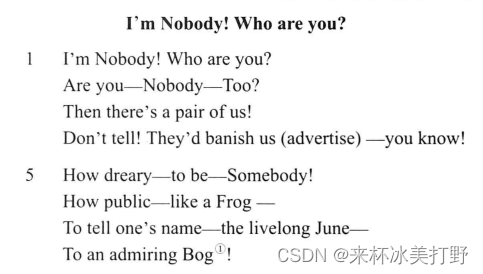
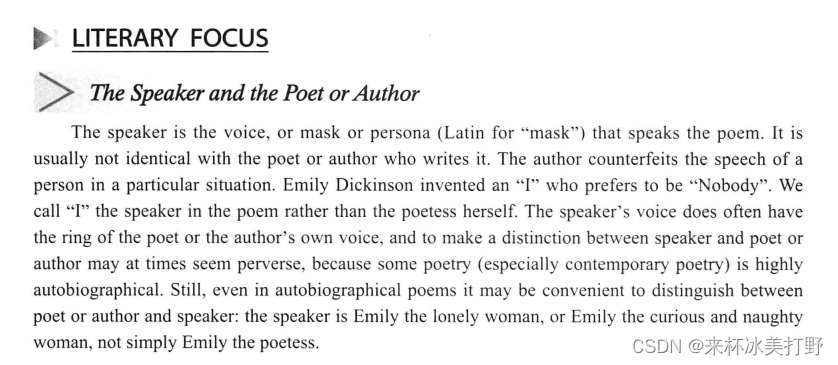




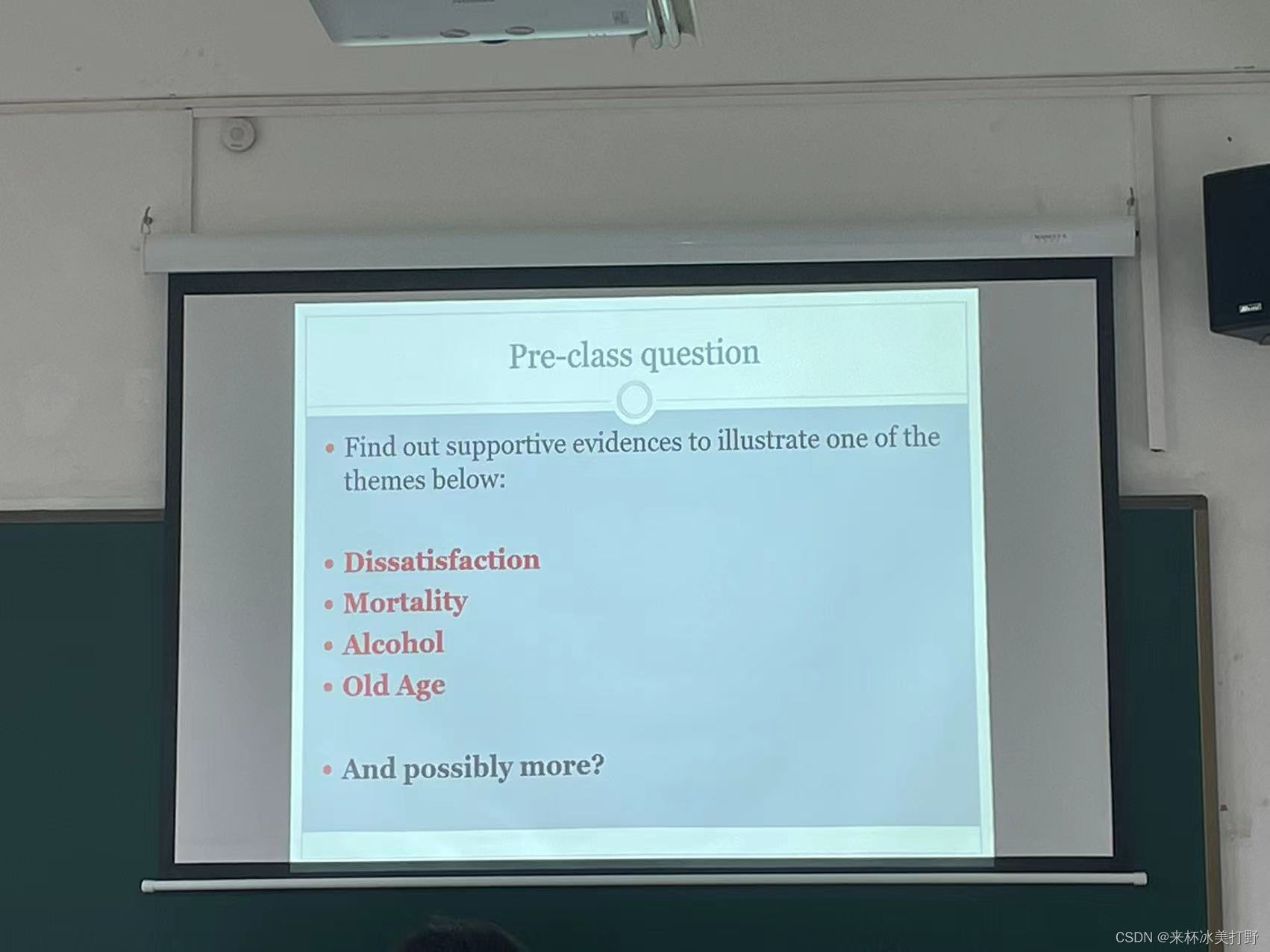

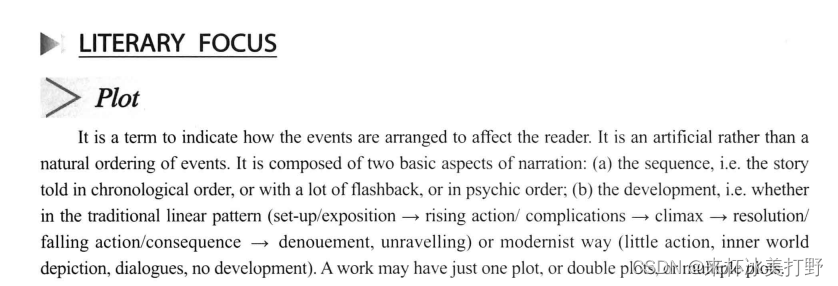
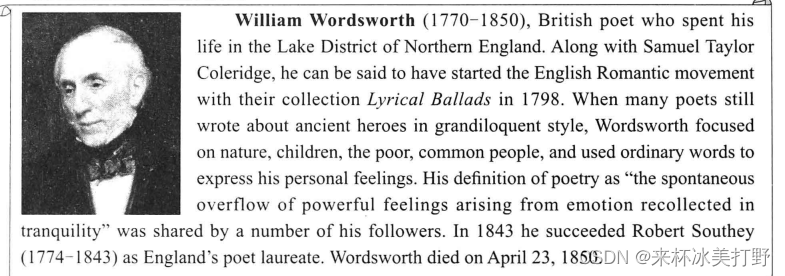

 、
、